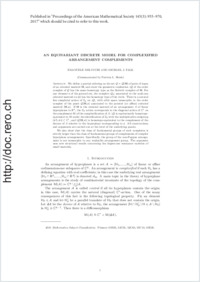An equivariant discrete model for complexified arrangement complements
- Delucchi, Emanuele Department of Mathematics, University of Fribourg, Chemin du musée 23, 1700 Fribourg, Switzerland
- Falk, Michael J. Department of Mathematics and Statistics, Northern Arizona University, Flagstaff, Arizona, USA
-
2017
Published in:
- Proceedings of the American Mathematical Society. - 2017, vol. 145, no. 3, p. 955–970
English
We define a partial ordering on the set $ \mathcal {Q}=\mathcal {Q}(\mathsf {M})$ of pairs of topes of an oriented matroid $ \mathsf {M}$, and show the geometric realization $ \vert\mathcal {Q}\vert$ of the order complex of $ \mathcal {Q}$ has the same homotopy type as the Salvetti complex of $ \mathsf {M}$. For any element $ e$ of the ground set, the complex $ \vert\mathcal {Q}_e\vert$ associated to the rank-one oriented matroid on $ \{e\}$ has the homotopy type of the circle. There is a natural free simplicial action of $ \mathbb{Z}_4$ on $ \vert\mathcal {Q}\vert$, with orbit space isomorphic to the order complex of the poset $ \mathcal {Q}(\mathsf {M},e)$ associated to the pointed (or affine) oriented matroid $ (\mathsf {M},e)$. If $ \mathsf {M}$ is the oriented matroid of an arrangement $ \mathscr {A}$ of linear hyperplanes in $ \mathbb{R}^n$, the $ \mathbb{Z}_4$ action corresponds to the diagonal action of $ \mathbb{C}^*$ on the complement $ M$ of the complexification of $ \mathscr {A}$: $ \vert\mathcal {Q}\vert$ is equivariantly homotopy-equivalent to $ M$ under the identification of $ \mathbb{Z}_4$ with the multiplicative subgroup $ \{\pm 1, \pm i\}\subset \mathbb{C}^*$, and $ \vert\mathcal {Q}(\mathsf {M},e)\vert$ is homotopy- equivalent to the complement of the decone of $ \mathscr {A}$ relative to the hyperplane corresponding to $ e$. All constructions and arguments are carried out at the level of the underlying posets.We also show that the class of fundamental groups of such complexes is strictly larger than the class of fundamental groups of complements of complex hyperplane arrangements. Specifically, the group of the non- Pappus arrangement is not isomorphic to any realizable arrangement group. The argument uses new structural results concerning the degree-one resonance varieties of small matroids.
- Faculty
- Faculté des sciences et de médecine
- Department
- Département de Mathématiques
- Language
-
- English
- Classification
- Mathematics
- License
- License undefined
- Identifiers
-
- RERO DOC 279937
- DOI 10.1090/proc/13328
- Persistent URL
- https://folia.unifr.ch/unifr/documents/305219
Statistics
Document views: 65
File downloads:
- del_edm.pdf: 134
